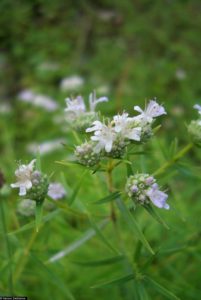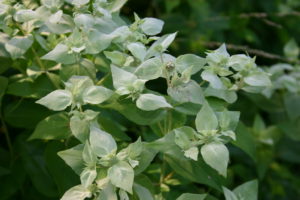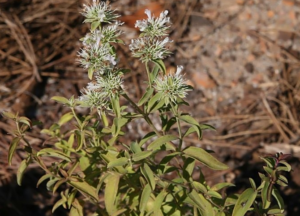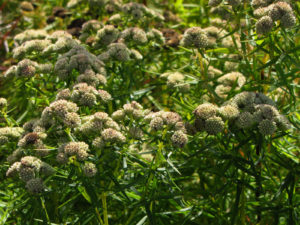Mountain mint plants are underused in the landscape. With dainty white blooms, a clumping habit and tons of genera to choose from, mountain mints (Pycnanthemum sp.) can fit in any style of garden. P. tenuifolium, P. virginiana, P. flexuosum, and P. muticum are the species most often available for purchase at FloraKansas. I always wonder why they don’t fly off the greenhouse bench at our sales – it must be because people don’t know enough about them!
Piqued for Pycnanthemum
All species in the Pycnanthemum (pick-nan-the-mum) genus are native to North America. They are in the mint family, so the leaves have that delicious, refreshing mint aroma when crushed. They spread via rhizomes and left unchecked can cover ground fast, though not quite as aggressively as other members of mint family. The blooms attract a wide array of pollinators. It is a special favorite among bees, flies and wasps, though swallowtails, grey hairstreaks, buckeyes and skippers often visit them as well. Ironically, mountain mints most often thrive in meadows and grassy prairies, not in alpine situations.
So Many Mints, So Little Time
There are lots of varieties of mountain mint out there, but the various species can be tricky to tell apart for the layperson. The blooms are all very similar: round and clustered, whitish to light purple, with spots. However, the leaves do have distinct shapes that vary between species. My favorites are the thin leaved species such as P. virginiana and P. tenuifolium.

P. tenuifolium, narrowleaf mountain mint. Photo credit: Nelson DeBarros, hosted by the USDA-NRCS PLANTS Database
P. muticum is easily recognized by its teardrop-shaped leaves, much wider than the other species. Found from Texas and Missouri all the way to Maine, this native grows in moist meadows and woodland areas. Like all mountain mints, it likes full sun to part sun and average soil moisture.

The short, stout leaves of P. muticum. I, SB Johnny [GFDL (http://www.gnu.org/copyleft/fdl.html) or CC-BY-SA-3.0 (http://creativecommons.org/licenses/by-sa/3.0/)], from Wikimedia Commons

Appalachian mountain mint, P. flexuosum By Photo by David J. Stang [CC BY-SA 4.0 (https://creativecommons.org/licenses/by-sa/4.0)], via Wikimedia Commons

P. tenuifolium By Katja Schulz from Washington, D. C., USA (Slender Mountain Mint) [CC BY 2.0 (https://creativecommons.org/licenses/by/2.0)], via Wikimedia Commons

